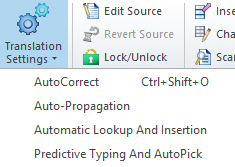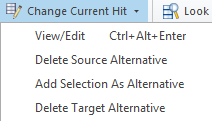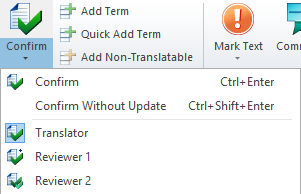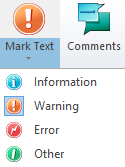Ribbons: Translation
The Translation ribbon appears when you work on a document in the translation editor.


AutoCorrect: Shows or changes AutoCorrect settings. Opens the AutoCorrect settings window. Shortcut key: Ctrl+Shift+O.
Auto-Propagation: Shows or changes how memoQ inserts translations for repeated segments. Opens the Auto-propagation settings window.
Automatic Lookup and Insertion: Shows or changes the way memoQ automatically scans for results in resources, and how it inserts the best full, fragment-assembled, or machine-translated result into the target cell. Opens the Automatic lookup and insertion window.
Predictive Typing and AutoPick: Shows or changes settings for predictive typing of terms, auto-translated parts, and suggestions from Muses; and settings for picking tags, numbers, terms, and other "placeables" from the source cells. Opens the Predictive typing and AutoPick window.
Edit Source: Normally, you would not modify source text. But with this command, you can. It is useful when you need to correct a typo or a mistake in the source segment, so that the translation memory will have the correct source text. Shortcut key: F2.
Revert Source: Restores the original text of the current source segment. Use this after you edit a source segment..
Lock/Unlock: Locks the selected segments if at least one of them is not locked. Unlocks the selected segments if all of them are locked. Shortcut key: Ctrl+Shift+L.
Insert Selected Hit: Opens a menu:

- Current hit: Inserts the selected suggestion from the Translation results list into the target cell. Shortcut key: Ctrl+Space.
- Assembled Hit: Inserts the translation result assembled from fragments, if there is one. Shortcut key: F4.
- Insert Next Auto-Translation: Inserts the next auto-translation result. Auto-translation results get to Translation results when there is a match or two for auto-translation rules in the source cell. These appear in green.
Change Current Hit: Changes the entry that belongs to the selected match in the Translation results list. Works if the selected entry comes from a term base or from a translation memory. A menu appears (the example is for a term base hit):

- View/Edit: Opens the editing window for the translation memory entry or term base entry that is selected in the Translation results list. Shortcut key: Ctrl+Alt+Enter.
- Delete Source Alternative: Deletes the source term from the selected term base entry.
- Add Selection as Alternative: Adds the selected target text as another term to the term base entry selected in the Translation results list.
- Delete Target Alternative: Deletes the target term from the selected term base entry.
- Delete Entry: Deletes the selected translation memory entry.
Scan Segment: If memoQ does not do automatic lookups, you must scan the segments for matches manually. You may need to do this for the first segment in a document. Click this to get suggestions in the Translation results list. Shortcut key: F3.
Concordance: Finds the selected text in the translation memories and LiveDocs corpora of the project. Opens the Concordance window. Shortcut key: Ctrl+K.
Look Up Term: Finds the selected text in the term bases of the project. Opens the Look up term window. Shortcut key: Ctrl+P.
memoQ Web Search: Finds the selected text on a set of pre-defined web pages. Opens the memoQ web search window. Before you can use this, you must set up the web sites. Shortcut key: Ctrl+F3.
Confirm: Confirms the current segment, saves the translation in the working translation memory, and moves to the next segment. Shortcut key: Ctrl+Enter. If you need more options, click the Confirm label below the icon. A menu appears:

- Confirm: Confirms the current segment, saves the translation in the working translation memory, and moves to the next segment. Shortcut key: Ctrl+Enter.
- Confirm Without Update: Confirms the current segment and moves to the next segment, but does not save the translation in the working translation memory. Shortcut key: Ctrl+Shift+R. You must confirm segments using this command when there is no working translation memory in the project.
- Translator, Reviewer 1, Reviewer 2: Sets your current role. When you confirm a segment, memoQ indicates the selected role with the Confirmed status. You cannot choose if you are working on the checkout of an online project because there your role is set by the project manager.
Add Term: Adds the highlighted text to one or more term bases as a new term. Opens the Create term base entry window. Shortcut key: Ctrl+E.
Quick Add Term: Works only if text is selected in the source cell and in the target cell. Adds the two selections to the first term base of the project as a new entry. Does not open a window. Shortcut key: Ctrl+Q.
Add Non-Translatable: Adds a new item to the default non-translatable list of the project. Open the Add non-translatable window.
Mark Text: Starts marking the text. Click the icon, then select text. The selected text will be highlighted. Shortcut key: Ctrl+Shift+M. Normally, memoQ uses orange (Warning). To use different colors, click the Mark text label below the icon, and choose a color (and a severity level) from this menu:

To stop marking, click the Mark text icon again.
Comments: Adds comments to the current segment, or shows the existing comments. Opens the Notes window. (If you are working on the checkout of an online project, it will also show a Discussions tab.) Shortcut key: Ctrl+M.
Spell Check: Runs spell (and grammar) checking on the document in the Spelling window. Shortcut key: F7. To set up spelling, open Options, and choose Spelling and grammar.
Errors and Warnings: Shows the warnings and errors for the current segment. You can mark them as ignored. Opens the Warnings window. Shortcut key: Ctrl+W.
Requires purchasing a third-party product: This section only appears if you purchased and installed Antidote Corrector.
Antidote Corrector: Opens the main window of Antidote Corrector.